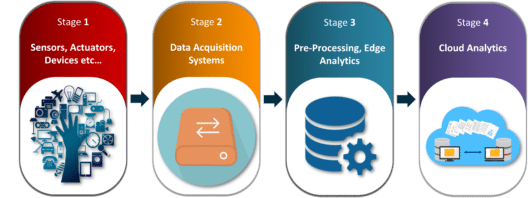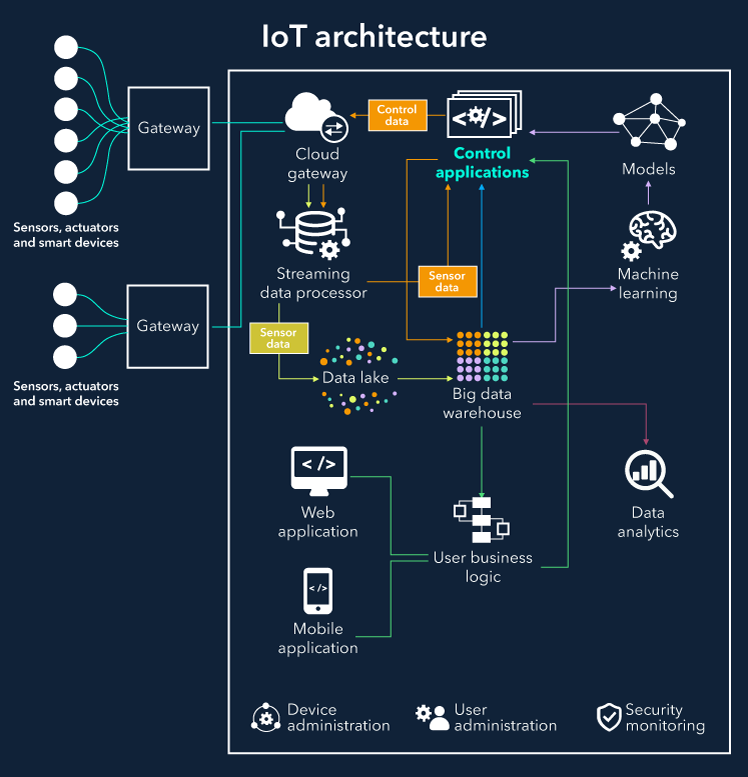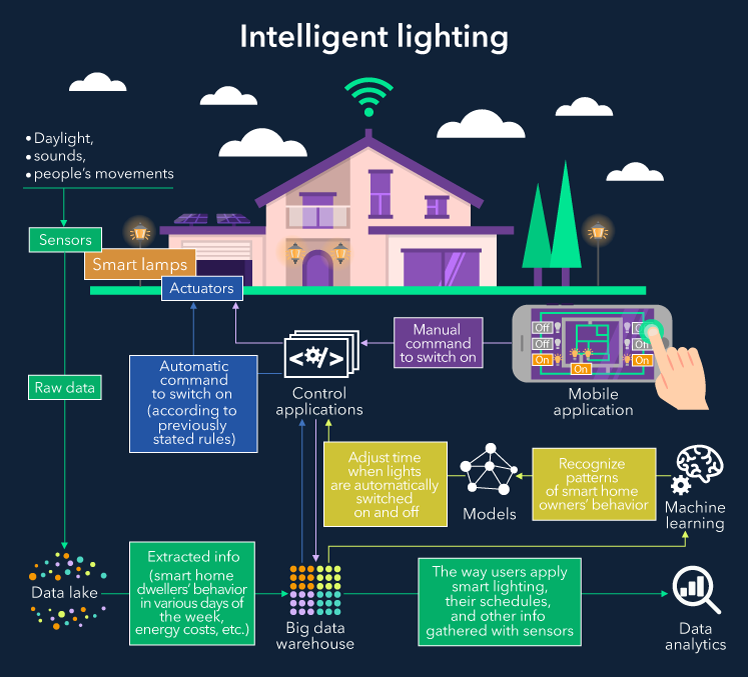IoT-A Overview
What is the Internet of Things? - the concept of connecting any device (so long as it has an on/off switch) to the Internet and to other connected devices. The IoT is a giant network of connected things and people – all of which collect and share data about the way they are used and about the environment around them.
How does it work? Devices and objects with built in sensors are connected to an Internet of Things platform, which integrates data from the different devices and applies analytics to share the most valuable information with applications built to address specific needs.
These powerful IoT platforms can pinpoint exactly what information is useful and what can safely be ignored. This information can be used to detect patterns, make recommendations, and detect possible problems before they occur.
For example, if a car manufacturing business, might want to know which optional components (leather seats or alloy wheels, for example) are the most popular. Using Internet of Things technology It is possible to:
Use sensors to detect which areas in a showroom are the most popular, and where customers linger longest;
Drill down into the available sales data to identify which components are selling fastest;
Automatically align sales data with supply, so that popular items don’t go out of stock.
The information picked up by connected devices enables to make smart decisions about which components to stock up on, based on real-time information, which helps save time and money.
With the insight provided by advanced analytics comes the power to make processes more efficient. Smart objects and systems mean you can automate certain tasks, particularly when these are repetitive, mundane, time-consuming or even dangerous.
IoT-Scenarios
Scenario #1: IoT in your home
Imagine a person wakes up at 7am every day to go to work. If his train’s cancelled and he has to drive to work instead. He would have needed to get up at 6.45am to avoid being late.
If it’s pouring with rain, so he will need to drive slower than usual.
A connected or IoT-enabled alarm clock would reset itself based on all these factors, to ensure you got to work on time.
It could recognize that your usual train is cancelled, calculate the driving distance and travel time for your alternative route to work, check the weather and factor in slower travelling speed because of heavy rain, and calculate when it needs to wake you up so you’re not late.
Scenario #2: IoT in transport
While driving to work, In a connected car, the sensor that triggered the check engine light would communicate with others in the car.
A component called the diagnostic bus collects data from these sensors and passes it to a gateway in the car, which sends the most relevant information to the manufacturer’s platform.
The manufacturer can use data from the car to offer you an appointment to get the part fixed, send you directions to the nearest dealer, and make sure the correct replacement part is ordered so it’s ready for you when you show up.
Internet of things- Components
A thing, in the Internet-of-Thing, can be a person or animal or any object that can generate data through a built-in sensor, or any other natural or man-made object that can be assigned an IP address and provided with the ability to transfer data over a network.
Sensors: A sensor is a transducer, whose purpose is to sniff a wide variety of information ranging from Location, Weather/Environment conditions, Grid parameters, Movement on assembly lines, Jet engine maintenance data to Health essentials of a patient and generate output as an electrical or optical signal. The sensors in the IOT are called as a node that will collect information and sent to the outside world, through communication protocols – Bluetooth, BLE, ZigBee, Z-wave, Wi-Fi or through wired communication. These nodes will be forwarding the data to a device called Gateway.
IOT Gateway: The gateway acts as a bridge between these IOT objects and the internet. Gateways can connect to the IoT devices that communicate via specific protocols, store and parse the information and then send them over to cloud servers for processing and analytics. IOT gateways not only abstract the medium of communication but also provide the secure channel required for the transmission of this data. Gateways usually run real-time operation systems (RTOS) or a form of Linux to drive their systems. Hardware and software level encryption is built right into the gateway to provide a secure channel for communication.
Cloud platform and Big data Analytics: The protocols that support cloud platform are– GPRS, Wi-Fi, CoAP, MQTT, WebSocket, RESTful, etc. Cloud computing is the only platform to support the massive and unpredictable data. Cloud will empower IOT by providing elastic computing power, storage and networking. The massive data generated from IOT can be analyzed in the cloud with big data solutions to gain insights and patterns of usage and behaviour of machines and humans. This business intelligence, in turn, allows us to predict forthcoming growth in data demand and deploy additional resources accordingly.
These patterns are then analysed, and if found irrelevant, then accordingly the information is sent to the user, to control & monitor their devices (ranging from room thermostat to jet engines & assembly lines) from remote locations. These apps push the important information on your hand-held devices & help to send commands to your Smart Devices.
However, the communication flow can also be in a reverse manner when user/ manufacturer want to actuate any object
User/ manufacturer will give some input in the form of SMS, Push, Email, Call, etc.
That information is forwarded to the internet i.e. Cloud
The cloud then processes the information identifies the particular object through the IP address and pushes the information through the communication protocols to the Gateway.
Gateway will trigger the actuator that will be responsible for controlling and moving the system or object.
Internet of things- Architecture
Stage 1 (Sensors/Actuators): A thing in the context of “Internet of Things”, should be equipped with sensors and actuators thus giving the ability to emit, accept and process signals.
Stage 2 (Data Acquisition Systems): The data from the sensors starts in analogue form which needs to be aggregated and converted into digital streams for further processing. Data acquisition systems perform these data aggregation and conversion functions.
Stage 3 (Edge Analytics): Once IoT data has been digitized and aggregated, it may require further processing before it enters the data center, this is where Edge Analytics comes in.
Stage 4 (Cloud Analytics): Data that needs more in-depth processing gets forwarded to physical data centers or cloud-based systems.

IoT architecture: building blocks and how they work
Things. A “thing” is an object equipped with sensors that gather data which will be transferred over a network and actuators that allow things to act (for example, to switch on or off the light, to open or close a door, to increase or decrease engine rotation speed and more). Sensors are not in all cases physically attached to the things: sensors may need to monitor, for example, what happens in the closest environment to a thing.
Gateways. Data goes from things to the cloud and vice versa through the gateways. A gateway provides connectivity between things and the cloud part of the IoT solution, enables data preprocessing and filtering before moving it to the cloud (to reduce the volume of data for detailed processing and storing) and transmits control commands going from the cloud to things. Things then execute commands using their actuators.
Cloud gateway facilitates data compression and secure data transmission between field gateways and cloud IoT servers. It also ensures compatibility with various protocols and communicates with field gateways using different protocols depending on what protocol is supported by gateways.
Streaming data processor ensures effective transition of input data to a data lake and control applications. No data can be occasionally lost or corrupted.
Data lake. A data lake is used for storing the data generated by connected devices in its natural format. Big data comes in "batches" or in “streams”. When the data is needed for meaningful insights it’s extracted from a data lake and loaded to a big data warehouse.
Big data warehouse. Filtered and preprocessed data needed for meaningful insights is extracted from a data lake to a big data warehouse. A big data warehouse contains only cleaned, structured and matched data (compared to a data lake which contains all sorts of data generated by sensors). Also, data warehouse stores context information about things and sensors (for example, where sensors are installed) and the commands control applications send to things.
Data analytics. Data analysts can use data from the big data warehouse to find trends and gain actionable insights. When analyzed (and in many cases – visualized in schemes, diagrams, infographics) big data show, for example, the performance of devices, help identify inefficiencies and work out the ways to improve an IoT system (make it more reliable, more customer-oriented). Also, the correlations and patterns found manually can further contribute to creating algorithms for control applications.
Machine learning and the models ML generates. With machine learning, there is an opportunity to create more precise and more efficient models for control applications. Models are regularly updated (for example, once in a week or once in a month) based on the historical data accumulated in a big data warehouse. When the applicability and efficiency of new models are tested and approved by data analysts, new models are used by control applications.
Control applications send automatic commands and alerts to actuators, for example:
Windows of a smart home can receive an automatic command to open or close depending on the forecasts taken from the weather service.
When sensors show that the soil is dry, watering systems get an automatic command to water plants.
Sensors help monitor the state of industrial equipment, and in case of a pre-failure situation, an IoT system generates and sends automatic notifications to field engineers.
The commands sent by control apps to actuators can be also additionally stored in a big data warehouse. This may help investigate problematic cases (for example, a control app sends commands, but they are not performed by actuators – then connectivity, gateways and actuators need to be checked). On the other side, storing commands from control apps may contribute to security, as an IoT system can identify that some commands are too strange or come in too big amounts which may evidence security breaches (as well as other problems which need investigation and corrective measures).
Control applications can be either rule-based or machine-learning based. In the first case, control apps work according to the rules stated by specialists. In the second case, control apps are using models which are regularly updated (once in a week, once in a month depending on the specifics of an IoT system) with the historical data stored in a big data warehouse.
Although control apps ensure better automation of an IoT system, there should be always an option for users to influence the behavior of such applications (for example, in cases of emergency or when it turns out that an IoT system is badly tuned to perform certain actions).
User applications are a software component of an IoT system which enables the connection of users to an IoT system and gives the options to monitor and control their smart things (while they are connected to a network of similar things, for example, homes or cars and controlled by a central system). With a mobile or web app, users can monitor the state of their things, send commands to control applications, set the options of automatic behavior (automatic notifications and actions when certain data comes from sensors).
Device management
To ensure sufficient functioning of IoT devices, there are procedures required to manage the performance of connected devices (facilitate the interaction between devices, ensure secure data transmission and more):
Device identification to establish the identity of the device to be sure that it’s a genuine device with trusted software transmitting reliable data.
Configuration and control to tune devices according to the purposes of an IoT system. Some parameters need to be written once a device is installed (for example, unique device ID). Other settings might need updates (for example, the time between sending messages with data).
Monitoring and diagnostics to ensure smooth and secure performance of every device in a network and reduce the risk of breakdowns.
Software updates and maintenance to add functionality, fix bugs, address security vulnerabilities.
User management
User management involves identifying users, their roles, access levels and ownership in a system. It includes such options as adding and removing users, managing user settings, controlling access of various users to certain information, as well as the permission to perform certain operations within a system, controlling and recording user activities and more.
Security monitoring
Connected things produce huge volumes of data, which need to be securely transmitted and protected from cyber-criminals. The things connected to the Internet can be entry points for unauthorised elements who can get the access to the “brain” of the whole IoT system and take control of it.
To prevent such problems, we log and analyze the commands sent by control applications to things, monitor the actions of users and store all these data in the cloud. With such an approach, it’s possible to address security breaches at the earlies stages and take measures to reduce their influence on an IoT system (for example, block certain commands coming from control applications).
Also, it’s possible to identify the patterns of suspicious behavior, store these samples and compare them with the logs generated by an IoT systems to prevent potential penetrations and minimize their impact on an IoT system.

IoT architecture example – Intelligent lighting
Manual monitoring and manual control Users control smart lighting system with a mobile app featuring the map of the yard. With the app users can see which lights are on and off and send commands to the control applications that further transmit them to lamp actuators. Such an app can also show which lamps are about to be out of order.
Data analytics Analyzing the way users apply smart lighting, their schedules (either provided by users or identified by the smart system) and other information gathered with sensors, data analysts can make and update the algorithms for control applications.
Data analytics also helps in assessing the effectiveness of the IoT system and revealing problems in the way the system works. For example, if a user switches off the light right after a system automatically switches it on and vice versa, there might be gaps in the algorithms, and it’s necessary to address them as soon as possible.
Automatic control’s options and pitfalls The sensors monitoring natural light send the data about the light to the cloud. When the daylight is not enough (according to previously stated threshold), the control apps send automatic commands to the actuators to switch on the lamps. The rest of the time the lamps are switched off.
Extraneous light captured by sensors can make the smart system conclude that it’s enough light, and lighting should be switched off. Thus, it makes sense to give the smart system a better understanding of the factors that influence lighting and accumulate these data in the cloud.
When sensors monitor motions and sounds, it’s not enough just to switch on the light when movements or sounds are identified in the yard or switch all the lamps off in the silence. Movements and sounds can be produced, for example, by pets, and cloud applications should distinguish between human voices and movements and those of pets. The same is about the noises coming from the street and neighboring houses and other sounds. To address this issue, it’s possible to store the examples of various sounds in the cloud and compare them with the sounds coming from the sensors.
Machine learning Intelligent lighting can apply models generated by machine learning, for example, to recognize the patterns of smart home owners’ behavior (leaving home at 8 am, coming back at 7 pm) and accordingly adjust the time when lights are switched on and off (for example, switch the lamps on 5 minutes before they will be needed).
Analyzing users’ behavior in long-time perspective, a smart system can develop advanced behavior. For example, when sensors don’t identify typical movements and voices of home inhabitants, a smart system can “suppose” that smart home dwellers are on a holiday and adjust the behavior: for example, occasionally switch on the lights to give the impression that the house is not empty (for security reasons), but do not keep the lights on all the time to reduce energy consumption.
User management options To ensure efficient user management, the smart lighting system can be designed for several users with role distribution: for example, owner, inhabitants, guests. In this case, the user with the title “owner” will have full control over the system (including changing the patterns of smart light behavior and monitoring the status of the yard lamps) and priorities in giving commands (when several users give contradicting commands, an owner’s command will be the one control apps execute), while other users will have access to a limited number of the system’s functions. “Inhabitants” will be enabled to switch on and off the lamps with no opportunity to change settings. “Guests” will be able to switch on and off the light in some parts of the house and have no access to controlling the lights, for example, near the garage.
Apart from role distribution, it’s essential to consider ownership (as soon as one system can control over 100 thousand of households, and it’s important that a dweller of a smart home manages the lighting in his yard, and not the one of a neighbor).
